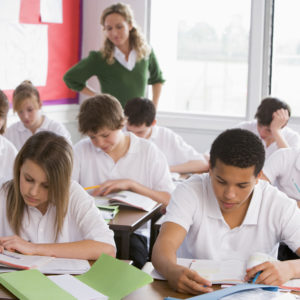Teachers unions talk about safety when they fight to keep classrooms closed during the COVID-19 pandemic. But the evidence points to politics as a higher priority in places like Chicago, where members have refused to resume in-person instruction.
Researchers at Boston College and the University of North Texas debunked the “safety first” narrative months ago with a nationwide analysis of back-to-school policies. The coauthors looked at COVID-19 infection and death rates in each county and found little correlation to choices about bringing students back to campus or keeping them home.
Public health data made little difference. Politics drove decisions instead, and teachers unions wielded significant influence in the process. The study shows that as collective bargaining power and union membership increased in each county, so did the likelihood that public schools would stick with virtual learning.
Power struggles played out nationwide in districts where parents preferred some form of in-person instruction. Even in places where voters and teachers unions agreed campuses should remain closed, an additional factor influenced local decisions.
The study shows district administrators moved faster to reopen public campuses when families had access to affordable private schools. The Chicago Board of Education has been keenly aware of the competitive risk, watching with alarm as Catholic schools have lured away students with promises of safe, in-person learning.
Homeschooling provides another exit threat. Parents who previously relied on neighborhood schools for daycare no longer receive that service and many families have adjusted by striking out on their own.
The one-two punch has left a mark. Since the pandemic started, public school enrollment has dropped almost everywhere, including declines of 15,000 students in Chicago and 20,000 in Washington, D.C.
The response from union lobbyists exposes their panic. Rather than leaving private schools alone to navigate public health requirements—the same as any other enterprise during the pandemic—teachers unions have tried to shut down their rivals.
In some places such as California and Oregon, the lobbying to stop in-person instruction at private schools has worked. Courts have intervened in other jurisdictions to stop the intrusion on parental rights. Our organization, the nonprofit Institute for Justice, describes the interference as “unconstitutional protectionism” in a friend-of-the-court brief filed in a Dane County case before the Wisconsin Supreme Court.
Teachers unions have attacked homeschoolers in a different way. Lobbyists can’t stop families from opting out of the public school system, so they shame them instead with warnings about “pandemic pods.” These study groups, which work like homeschool co-ops, allow children to meet in residential settings with instruction from private tutors or parents.
One union ally calls the pods “the latest in school segregation.” The implication is that parents who give their children an edge during the pandemic contribute to racial divisions by perpetuating performance gaps.
The overall message is clear. Teachers unions don’t want children gathering anywhere to learn. The unions don’t want public schools open. They don’t want private schools open. They don’t want pandemic pods open. Part of the reason might involve safety concerns, but the evidence shows greater concern about maintaining control.
Parents have noticed the upside-down priorities and pushed back, even in the communities where teachers unions traditionally have the most influence. Multiple sources already confirm a political shift in the school choice movement, no longer dominated by just conservatives.
A survey from RealClear Opinion Research shows Democrats, not Republicans, are most likely to enroll their children in a homeschool, neighborhood co-op, or virtual school once the campus lockdowns end. Overall, 59% of Democrats support school choice.
That’s bad news for teachers unions. They prefer to keep their political agendas hidden, but their masks have slipped during the pandemic. Medical experts have challenged their policy positions—using data rather than interpretive dance—and parents are growing restless.

